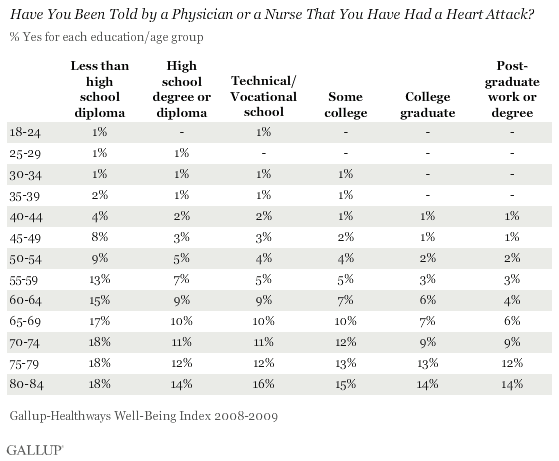PRINCETON, NJ -- The incidence of heart attacks, virtually nil in Americans' 20s and early 30s, begins to rise steadily among those aged 40 and older. By age 67, more than 10% of the adult population reports having had a heart attack, and by age 81, more than 15%.
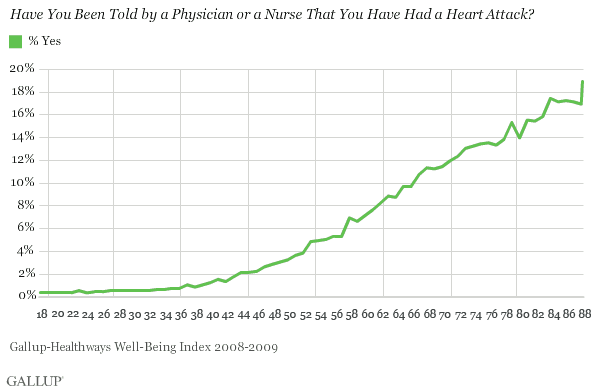
The heart attack data used in this analysis are based on 707,527 interviews conducted in 2008 and 2009 as part of the Gallup-Healthways Well-Being Index. This large sample provides the unique ability to document reports of having had a heart attack on a year-by-year basis from age 18 to age 90.
Each night, random samples of 1,000 American adults, aged 18 and older, are interviewed as part of the Gallup-Healthways Well-Being Index and asked, "Have you ever been told by a physician or nurse that you have any of the following, or not?," with "heart attack" included as one of a list of seven conditions. (The other conditions are high blood pressure, high cholesterol, diabetes, depression, asthma, and cancer.)
The results may understate the real-world incidence of heart attacks. By definition, all reports are based on respondents still living at the time of the interview; those who died either as an immediate or longer term result of a heart attack before the time of the interview are not included in this study. This analysis is also dependent on respondent self-reports and not official diagnoses as reported by clinicians. Even with the rigorous question wording, which asks respondents if they have been given an official diagnosis of a heart attack by a physician or nurse, it is possible that some respondents may report having had a heart attack who in a strict clinical fashion did not have actually have one. It is also possible that some respondents may have had a heart attack but were unaware of its occurrence.
Heart Attack Reports Higher Among Men
At each specific age point from Americans' mid-30s on, men are consistently more likely than women to report having had a heart attack, confirming one of cardiology's most basic epidemiological facts of life.
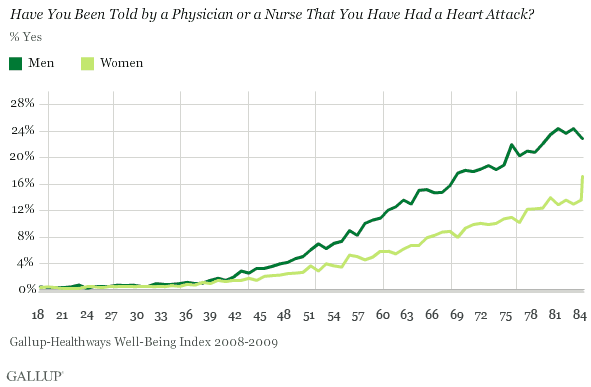
Although the same age-related trends occur among men and women, the gender gap in heart attack rates widens with each increasing year of age beyond Americans' mid-30s. Men who are in their late 60s and older are more than twice as likely as women of the same age to report that they have had a heart attack.
Overall, 5.7% of all men interviewed as part of this study report having had a heart attack, compared with 3.6% of women.
Those Without a High School Diploma More Likely to Report Heart Attacks
The data also show that education is significantly related to self-reported heart attack incidence.
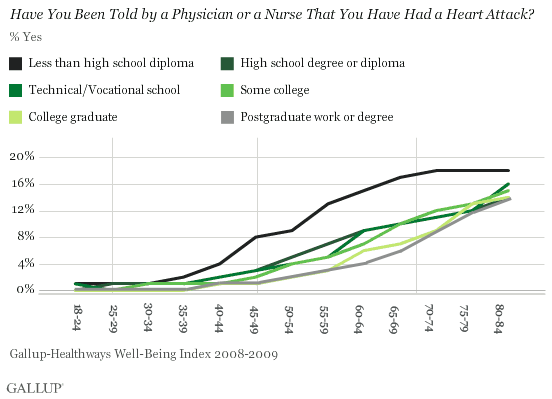
Beginning in their 30s, those without a high school degree are significantly more likely to report having had a heart attack than those of the same age who have higher levels of education. Americans who are college graduates and those with postgraduate education are less likely than others to report having had a heart attack up until about their mid-70s, at which time heart attack incidence converges among all but those with less than a high school degree.
Overall, the incidence of heart attacks among Americans who have less than a high school diploma are more than three times as high as among those with a postgraduate education.
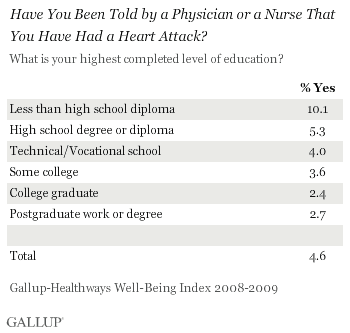
Bottom Line
These findings, based on a random sample of more than 700,000 adult Americans interviewed in 2008 and 2009, provide specific documentation of the self-reported, cumulative incidence of heart attack on a year-to-year basis in the contemporary American population. The findings make it clear that heart attack incidence climbs steadily and continually from about age 40 on. Additionally, men are increasingly more likely than women to report having had a heart attack at each age point from Americans' 30s on. Those who do not have a high school degree are considerably more likely than others to report having had a heart attack at all ages. Americans with college degrees are less likely than others to report having had a heart attack.
See page 2 for the full data for each of the relationships this analysis reports.
Learn more about the Gallup-Healthways Well-Being Index.
Survey Methods
Results are based on telephone interviews with an aggregated random sample of 707,527 national adults, aged 18 and older, conducted as part of Gallup Daily tracking/Gallup-Healthways Well-Being Index in 2008 and 2009. For results based on the total sample of national adults, one can say with 95% confidence that the maximum margin of sampling error is less than 1 percentage point. All reported margins of sampling error include the computed design effects for weighting and sample design.
Interviews are conducted with respondents on landline telephones and cellular phones, with interviews conducted in Spanish for respondents who are primarily Spanish speaking. Each sample includes a minimum quota of 150 cell phone respondents and 850 landline respondents, with additional minimum quotas among landline respondents for gender within region. Landline respondents are chosen at random within each household on the basis of which member had the most recent birthday.
Samples are weighted on the basis of gender, age, race, Hispanic ethnicity, education, region, adults in the household, cell phone-only status, cell phone-mostly status, and phone lines. Demographic weighting targets are based on the March 2009 Current Population Survey figures for the aged 18 and older non-institutionalized population living in U.S. telephone households. All reported margins of sampling error include the computed design effects for weighting and sample design.
In addition to sampling error, question wording and practical difficulties in conducting surveys can introduce error or bias into the findings of public opinion polls.


